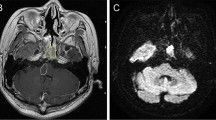Abstract
Purpose
This study aimed to assess the magnetic resonance (MRI) features of the superior cervical ganglion (SCG) and to track changes to it induced using radiotherapy across a long-term follow-up.
Methods
In total, 75 patients who underwent radiotherapy for head and neck malignancies and who were studied with MRI were recruited from two centers. MRI was performed before and after radiotherapy, with a median long-term follow-up of 4.5 years. Baseline SCG features were assessed. Changes in axial cross-sectional area, T2-normalized signal, and apparent diffusion coefficient (ADC) (the latter available in about half of the patients) were analyzed. Repeated measures analysis of variance with Bonferroni’s correction was used to analyze changes in the aforementioned parameters (significance level 0.05).
Results
Out of a potential 149 SCGs, 136 were visible at baseline MRI. A variable spatial relationship with the internal carotid artery was found. SCGs showed the “black dot” sign in almost all of the patients. ADC was higher in SCGs than in regional lymph nodes. Cross-sectional area, normalized T2, and ADC increased in the period up to 1 year after radiotherapy and then remained stable in subsequent longer-term follow-up.
Conclusion
The SCG has unusual features that allow differentiation from the regional lymph nodes. Changes in morphology and signal after radiotherapy must be taken into account by radiologists to avoid misdiagnosis as recurrent nodal disease. Changes induced using radiotherapy are stable in long-term follow-up and are thus likely attributed to other factors (such as Schwann cell hypertrophy/proliferation) rather than edema.





Similar content being viewed by others
Change history
05 April 2020
In the article ���Magnetic resonance imaging features of the superior cervical ganglion and expected changes after radiation therapy to the head and neck in a long-term follow-up���, one of the author names, K Chokkappan, was spelled incorrectly.
References
Civelek E, Karasu A, Cansever T, Hepgul K, Kiris T, Sabancı A, Canbolat A (2008) Surgical anatomy of the cervical sympathetic trunk during anterolateral approach to cervical spine. Eur Spine J 17:991–995. https://doi.org/10.1007/s00586-008-0696-8
Kiray A, Arman C, Naderi S et al (2005) Surgical anatomy of the cervical sympathetic trunk: surgical anatomy of the CST. Clin Anat 18:179–185. https://doi.org/10.1002/ca.20055
Saylam CY, Ozgiray E, Orhan M et al (2009) Neuroanatomy of cervical sympathetic trunk: a cadaveric study. Clin Anat 22:324–330. https://doi.org/10.1002/ca.20764
Wirz S, Wartenberg HC, Nadstawek J, Kinsky I (2008) Superior cervical ganglion: an anatomical variant. Are variations of the cranial carotid artery a risk factor for accidental intravascular injection? Anaesthesist 57:689–692. https://doi.org/10.1007/s00101-008-1378-y
Loke SC, Karandikar A, Ravanelli M, Farina D, Goh JPN, Ling EA, Maroldi R, Tan TY (2016) Superior cervical ganglion mimicking retropharyngeal adenopathy in head and neck cancer patients: MR features with anatomic, histologic, and surgical correlation. Neuroradiology 58:45–50. https://doi.org/10.1007/s00234-015-1598-1
Yokota H, Mukai H, Hattori S, Yamada K, Anzai Y, Uno T (2018) MR imaging of the superior cervical ganglion and inferior ganglion of the vagus nerve: structures that can mimic pathologic retropharyngeal lymph nodes. AJNR Am J Neuroradiol 39:170–176. https://doi.org/10.3174/ajnr.A5434
Hogan QH, Erickson SJ (1992) MR imaging of the stellate ganglion: normal appearance. Am J Roentgenol 158:655–659. https://doi.org/10.2214/ajr.158.3.1739014
Lee JY, Lee JH, Song JS, Song MJ, Hwang SJ, Yoon RG, Jang SW, Park JE, Heo YJ, Choi YJ, Baek JH (2016) Superior cervical sympathetic ganglion: normal imaging appearance on 3T-MR. Korean J Radiol 17:657–663. https://doi.org/10.3348/kjr.2016.17.5.657
Cho SJ, Lee JH, Park JE, Choi YJ, Kim JH, Kim HJ, Baek JH (2018) Serial magnetic resonance imaging evaluations of irradiated superior cervical sympathetic ganglia: not every retropharyngeal enlarging mass is a sign of malignancy. Eur J Radiol 98:126–129. https://doi.org/10.1016/j.ejrad.2017.11.008
Yuen HW, Goh CHK, Tan TY (2006) Enlarged cervical sympathetic ganglion: an unusual parapharyngeal space tumour. Singap Med J 47:321–323
Wisco JJ, Stark ME, Safir I, Rahman S (2012) A heat map of superior cervical ganglion location relative to the common carotid artery bifurcation. Anesth Analg 114:462–465. https://doi.org/10.1213/ANE.0b013e31823b676d
van der Kogel AJ (1977) Radiation-induced nerve root degeneration and hypertrophic neuropathy in the lumbosacral spinal cord of rats: the relation with changes in aging rats. Acta Neuropathol 39:139–145. https://doi.org/10.1007/bf00703320
Funding
No funding was received for this study.
Author information
Authors and Affiliations
Corresponding author
Ethics declarations
Conflict of interest
The authors declare that they have no conflict of interest.
Ethical approval
All procedures performed in the studies involving human participants were in accordance with the ethical standards of the institutional and/or national research committee and with the 1964 Helsinki Declaration and its later amendments or comparable ethical standards.
Informed consent
Informed consent was obtained from all individual participants included in the study.
Additional information
Publisher’s note
Springer Nature remains neutral with regard to jurisdictional claims in published maps and institutional affiliations.
Rights and permissions
About this article
Cite this article
Ravanelli, M., Tononcelli, E., Leali, M. et al. Magnetic resonance imaging features of the superior cervical ganglion and expected changes after radiation therapy to the head and neck in a long-term follow-up. Neuroradiology 62, 519–524 (2020). https://doi.org/10.1007/s00234-020-02373-4
Received:
Accepted:
Published:
Issue Date:
DOI: https://doi.org/10.1007/s00234-020-02373-4




